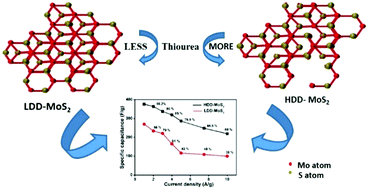Metallic 1T-MoS2 with defect induced additional active edges for high performance supercapacitor application
Abstract
Molybdenum disulphide (MoS2) is widely explored in the area of electrochemical energy storage devices as an alternative to graphene. Here we introduce a 1T-MoS2 electrode with defect induced active edges for high performance supercapacitors. The metallic phase (1T) facilitates enhanced electrical conductivity and defect rich morphology that results in a high specific capacitance value. The structural characterisation confirms the formation of 1T phase and defect concentration in the material. Transmission electron microscopy imaging further confirms the presence of defects in high defect density MoS2 (HDD-MoS2) and low defect density MoS2 (LDD-MoS2). The electrochemical studies show that the prepared high defect density MoS2 electrode exhibits a maximum specific capacitance of 379 F g−1 and 68.9 F g−1 at 1 A g−1 current density in three and two electrode systems, respectively. The symmetric HDD-MoS2 supercapacitor exhibits an outstanding cell performance with an energy density of 21.3 W h kg−1, at a power density of 750 W kg−1 and a capacitance retention of 92% after 3000 cycles. These findings suggest that 1T MoS2 with high defect density can be a potential candidate for high performance supercapacitor electrode application.



 Please wait while we load your content...
Please wait while we load your content...